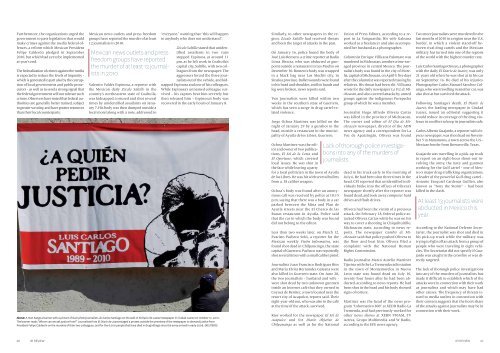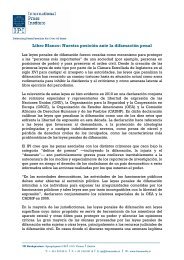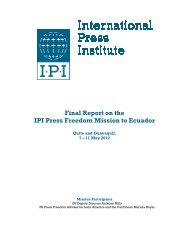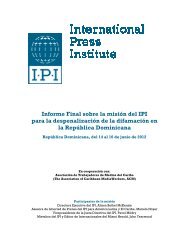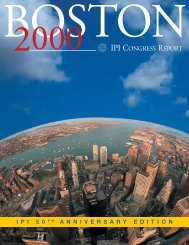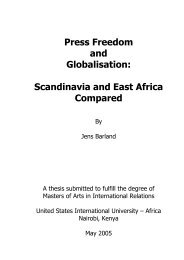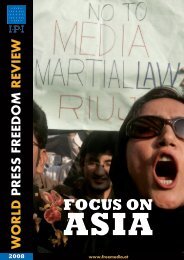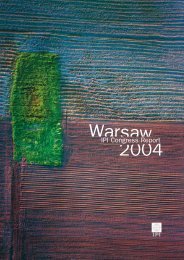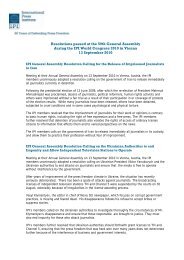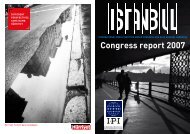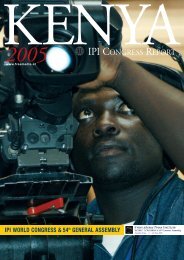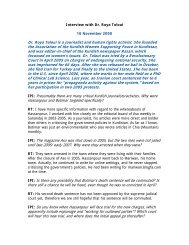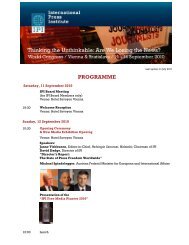FOCUS ON THE AMERICAS - International Press Institute
FOCUS ON THE AMERICAS - International Press Institute
FOCUS ON THE AMERICAS - International Press Institute
Create successful ePaper yourself
Turn your PDF publications into a flip-book with our unique Google optimized e-Paper software.
Furthermore, the organizations urged the<br />
government to pass legislation that would<br />
make crimes against the media federal offences,<br />
a reform which Mexican President<br />
Felipe Calderón pledged in September<br />
2010, but which had yet to be implemented<br />
at year’s end.<br />
The federalization of crimes against the media<br />
is expected to reduce the levels of impunity -<br />
which is generated in part also by the corruption<br />
of local governments and public prosecutors<br />
- as well as to send a strong signal that<br />
the federal government will not tolerate such<br />
crimes. Observers have noted that federal authorities<br />
are generally better trained, subject<br />
to greater scrutiny, and have greater resources<br />
than their local counterparts.<br />
Mexican news outlets and press freedom<br />
groups have reported the murder of at least<br />
12 journalists in 2010.<br />
Mexican news outlets and press<br />
freedom groups have reported<br />
the murder of at least 12 journalists<br />
in 2010.<br />
Valentín Valdés Espinosa, a reporter with<br />
the Mexican daily Zócalo Saltillo in the<br />
country’s northeastern state of Coahuila,<br />
was kidnapped, tortured and shot several<br />
times by unidentified assailants on January<br />
7. His body was then dumped outside a<br />
local motel along with a note, addressed to<br />
“everyone,” warning that “this will happen<br />
to anybody who does not understand”.<br />
Zócalo Saltillo stated that unidentified<br />
assailants in two vans<br />
stopped Espinosa at around 11<br />
pm, as he left work in Coahuila’s<br />
capital city, Saltillo, with two colleagues<br />
from the newspaper. The<br />
aggressors forced the three journalists<br />
out of the vehicle, and kidnapped<br />
Espinosa and one of his colleagues.<br />
While Espinosa’s unnamed colleague survived<br />
– his captors beat him severely but<br />
then released him – Espinosa’s body was<br />
recovered in the early hours of January 8.<br />
Above: A man hangs a banner with a picture of slain photojournalist Luis Carlos Santiago on the wall of El Diario de Juarez newspaper in Ciudad Juarez on October 12, 2010.<br />
The banner reads "Whom can we ask justice from?" Journalists from El Diario de Juarez staged a protest outside the premises of the newspaper to demand justice from<br />
President Felipe Calderón on the murders of their two colleagues, and for the 6,700 people that have died in drug killings since the army arrived in early 2008. (REUTERS)<br />
Similarly, to other newspapers in the region,<br />
Zócalo Saltillo had received threats<br />
and been the target of attacks in the past.<br />
On January 16, police found the body of<br />
José Luis Romero, a crime reporter at Radio<br />
Linea Directa, who was abducted at gunpoint<br />
outside a restaurant in Los Mochis on<br />
December 30. Romero’s body was wrapped<br />
in a black bag near Los Mochis city, in<br />
Sinaloa province. Bullet wounds were found<br />
in his head and shoulder, and his hands and<br />
leg were broken, news reports said.<br />
Two journalists were killed within two<br />
weeks in the southern state of Guerrero,<br />
which has seen a surge in drug cartel-related<br />
violence.<br />
Jorge Ochoa Martínez was killed on the<br />
night of January 29 by a gunshot to the<br />
head, outside a restaurant in the municipality<br />
of Ayutla de los Libres, Guerrero.<br />
Ochoa Martinez was the editor<br />
and owner of two publications,<br />
El Sol de la Costa and<br />
El Oportuno, which covered<br />
local issues. He was shot in<br />
the face while leaving a party<br />
for a local politician in the town of Ayutla<br />
de los Libres. He was hit with several bullets<br />
from a .38 caliber weapon.<br />
Ochoa's body was found after an anonymous<br />
call was received by police at 10:15<br />
p.m. saying that there was a body in a car<br />
parked between the Mina and Plan de<br />
Ayutla streets near the El Charco de las<br />
Ranas restaurant in Ayutla. Police said<br />
that the car in which the body was found<br />
did not belong to the editor.<br />
Less than two weeks later, on March 12,<br />
Evaristo Pacheco Solís, a reporter for the<br />
Mexican weekly Visión Informativa, was<br />
found shot dead in Chilpancingo, the state<br />
capital of Guerrero. Pacheco was reportedly<br />
shot several times with a small caliber pistol.<br />
Journalists Juan Francisco Rodríguez Ríos<br />
and Maria Elvira Hernández Galeana were<br />
also killed in Guerrero state. On June 28,<br />
the two journalists - husband and wife -<br />
were shot dead by two unknown gunmen<br />
inside an Internet café that they owned in<br />
Coyuca de Benitez, a town located near the<br />
resort city of Acapulco, reports said. Their<br />
eight-year-old son, who was also in the café<br />
at the time of the attack, survived.<br />
Ríos worked for the newspaper El Sol de<br />
Acapulco and for Diario Objetivo de<br />
Chilpancingo as well as for the National<br />
Union of <strong>Press</strong> Editors, according to a report<br />
in La Vanguardia. His wife Galeana<br />
worked as a freelancer and also accompanied<br />
her husband as a photographer.<br />
Columnist Enrique Villicana Palomare was<br />
murdered in Michoacan, another crime-ravaged<br />
province in central Mexico. The journalist’s<br />
body was found in the city of Morelia,<br />
capital of Michoacan, on April 9, five days<br />
after the columnist was reported missing by<br />
relatives. His throat had been slit. Villicana<br />
wrote for the daily newspaper La Voz de Michoacan,<br />
and also covered attacks by armed<br />
groups against the indigenous Purepecha<br />
group of which he was a member.<br />
Journalist Hugo Alfredo Olivera Cartas<br />
was killed in the province of Michoacan.<br />
The owner and editor of El Día de Michoacán<br />
newspaper, director of the ADN<br />
news agency and a correspondent for La<br />
Voz de Apatzingán, Olivera was found<br />
Lack of thorough police investigations<br />
into any of the murders of<br />
journalists.<br />
dead in his truck early in the morning of<br />
July 6. He had been shot three times in the<br />
head. CPJ reported that unidentified individuals<br />
broke into the offices of Olivera’s<br />
newspaper shortly after the reporter was<br />
found dead, and took away computer hard<br />
drives and flash drives.<br />
Olivera had been the victim of a previous<br />
attack. On February 18, federal police attacked<br />
Olivera Cartas while he was on his<br />
way to cover a shooting in Chiquihuitillo,<br />
Michoacán state, according to news reports.<br />
The newspaper Cambio de Michoacán<br />
said that police pushed Olivera to<br />
the floor and beat him. Olivera filed a<br />
complaint with the National Human<br />
Rights Commission.<br />
Radio journalist Marco Aurelio Martinez<br />
Tijerina with the La Tremenda radio station<br />
in the town of Montemorelos in Nuevo<br />
Leon state was found dead on July 10,<br />
twenty-four hours after he had been abducted,<br />
according to news reports. He had<br />
been shot in the head and his body showed<br />
signs of torture.<br />
Martinez was the head of the news program<br />
“Informativo 800” at XEDD Radio La<br />
Tremenda, and had previously worked for<br />
other news shows at XERN 950AM, TV<br />
Azteca, Grupo Multimedia and W Radio,<br />
according to the EFE news agency.<br />
Two more journalists were murdered in the<br />
last months of 2010 in a region near the U.S.<br />
border, in which a violent stand-off between<br />
rival drug cartels and the Mexican<br />
military has turned into one of the regions<br />
of the world with the highest murder rate.<br />
Luis Carlos Santiago Orozco, a photographer<br />
with the daily El Diario de Juarez, was only<br />
21 years old when he was shot at in his car<br />
on September 16. He died of his injuries.<br />
Photographer Carlos Manuel Sanchez Colunga,<br />
who was travelling in another car, was<br />
also shot at but survived the attack.<br />
Following Santiago’s death, El Diario de<br />
Juarez, the leading newspaper in Ciudad<br />
Juarez, issued an editorial suggesting it<br />
would reduce its coverage of the drug violence<br />
in an effort to keep its journalists safe.<br />
Carlos Alberto Guajardo, a reporter with Expreso<br />
newspaper, was shot dead on November<br />
5 in Matamoros, a town across the U.S.-<br />
Mexican border from Brownsville, Texas.<br />
Guajardo was travelling in a pick-up truck<br />
to report on an eight-hour shoot-out involving<br />
the army, the navy and gunmen<br />
working for the Gulf cartel - one of Mexico's<br />
major drug-trafficking organizations.<br />
A leader of the powerful Gulf drug cartel -<br />
Antonio Ezequiel Cardenas Guillen, also<br />
known as "Tony the Storm" – had been<br />
killed in the clash.<br />
At least 13 journalists were<br />
abducted in Mexico this<br />
year.<br />
According to the National Defense Secretariat,<br />
the journalist was shot and died in<br />
his pick-up truck while the military was<br />
trying to fight off an attack from a group of<br />
people who were traveling in eight vehicles.<br />
The Secretariat did not specify if Guajardo<br />
was caught in the crossfire or was directly<br />
targeted.<br />
The lack of thorough police investigations<br />
into any of the murders of journalists has<br />
made it difficult to establish which of the<br />
attacks were in connection with their work<br />
as journalists and which may have had<br />
other causes. The frequency of threats issued<br />
to media outlets in connection with<br />
their content suggests that the lion’s share<br />
of the attacks against journalists may be in<br />
connection with their work.<br />
26 IPI REVIEW<br />
IPI REVIEW 27


